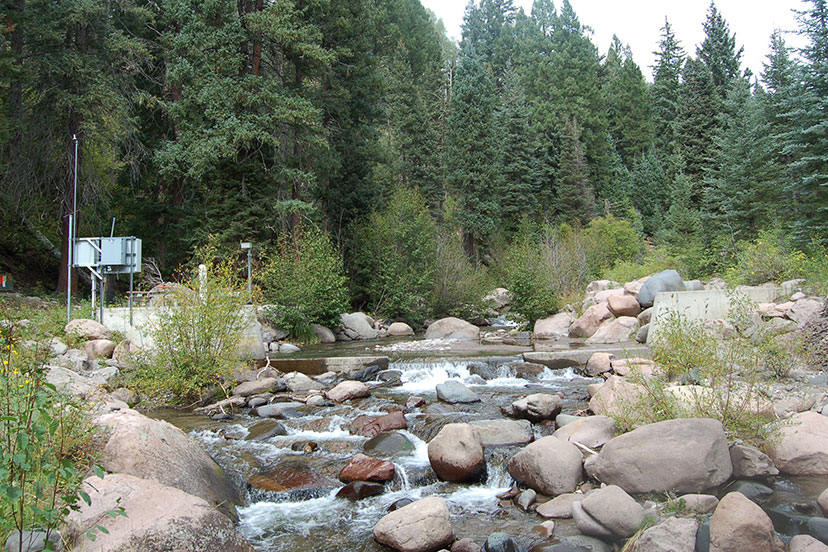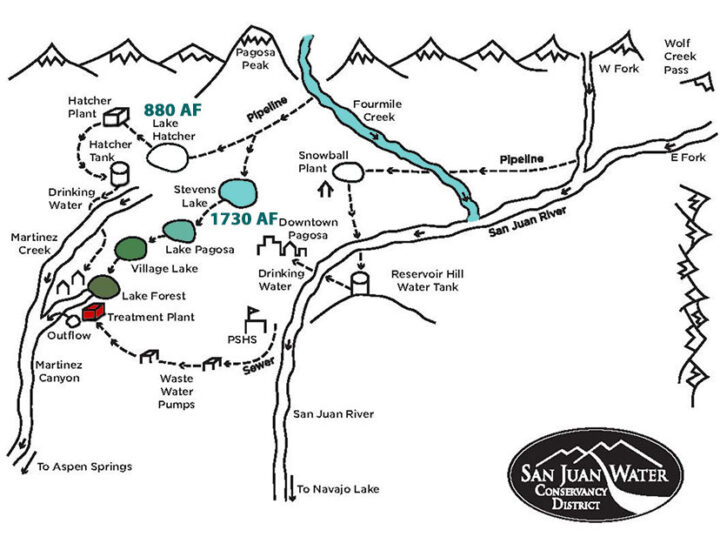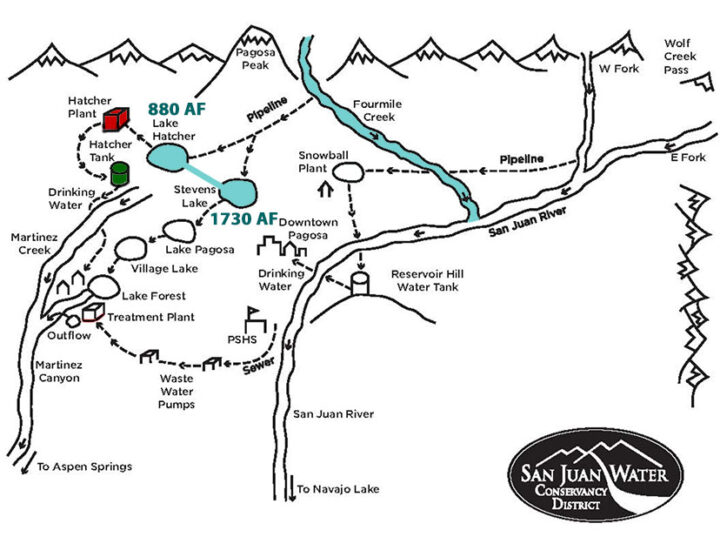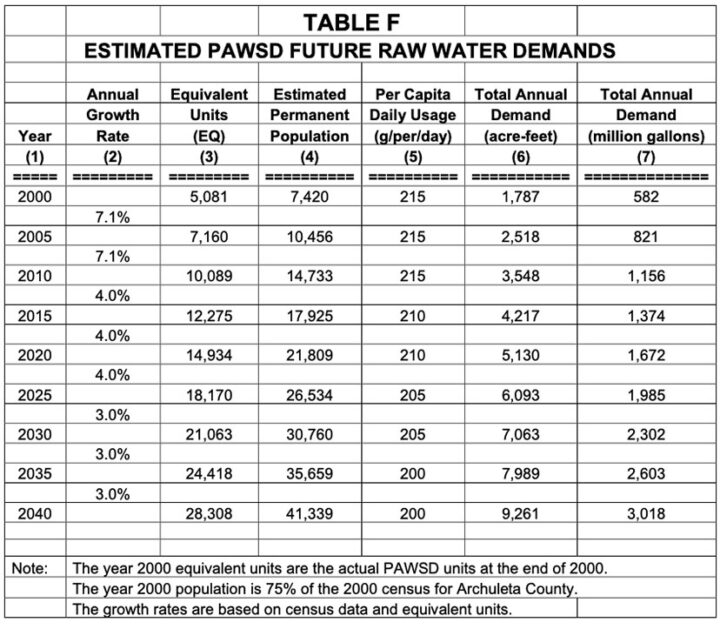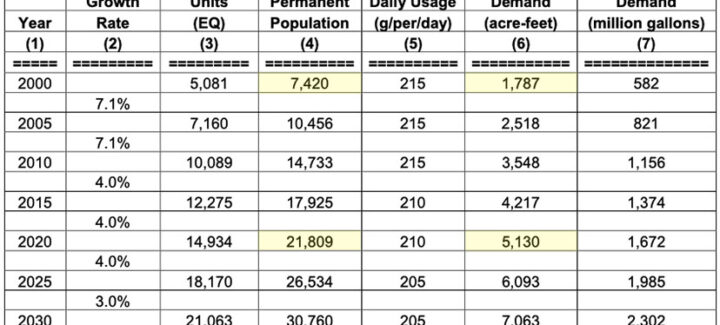As mentioned yesterday, the Hatcher Water Treatment Plant serves treated drinking water to Pagosa Area Water and Sanitation District (PAWSD) District 1, which is mainly the Pagosa Lakes area. The water is pulled from Lake Hatcher, and Lake Hatcher is fed by the Dutton Ditch. The diversion — sparkling water from snowmelt in the San Juan Mountains — is on Fourmile Creek.
The photo, above, shows the Fourmile Creek diversion site. When I was a kid growing up in California, my family would gladly drive half a day to spend time camping near, and fishing in, mountain streams like this.
Disclosure: I currently serve on the Pagosa Area Water and Sanitation District (PAWSD) board of directors, but this editorial reflects only my own personal opinions, and not necessarily those the PAWSD board as a whole.
When it’s full — and it’s nearly always full, in June — Lake Hatcher holds about 880 AF (acre-feet) of usable raw water. To put 880 AF of storage in context, PAWSD sells about 1,250 AF of treated water annually.
The sparkling mountain water from the Fourmile Diversion also flows into Stevens Reservoir, courtesy of the Dutton Ditch…
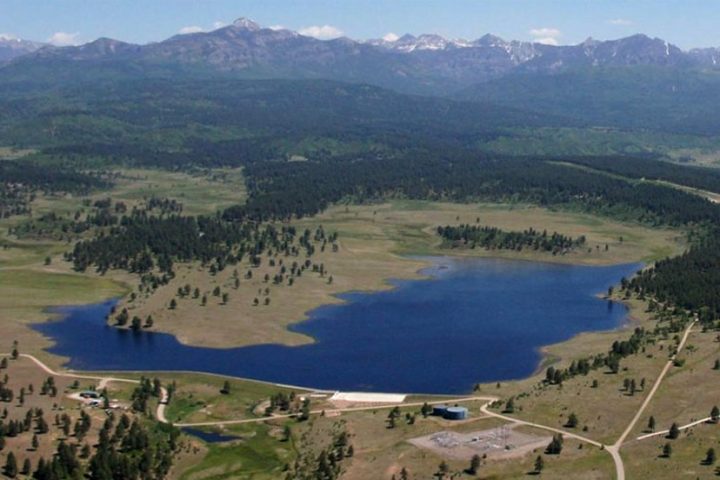
Also mentioned yesterday, Stevens was enlarged, at considerable expense, a dozen years ago, and now holds about 1730 AF of mountain water, when full.
But there’s a little problem, in terms of actually using the water stored in Stevens Reservoir.
Below is a map we shared yesterday, obtained from the San Juan Water Conservancy website. I’ve added color to the map to indicate Fourmile Creek, and Stevens Lake.
And three other lakes.
Even though PAWSD stores about 1730 AF of mountain water in Stevens Lake, they never built a pipeline to get the water to the Hatcher Treatment Plant. So the only way to use the water in Stevens is to spill it into Lake Pagosa… and then spill Lake Pagosa into Village Lake… and then spill Village Lake into Lake Forest…
…and then treat the water at the San Juan Treatment facility.
We can easily imagine that the once-clean mountain water is not quite so clean by the time it spills through four relatively stagnant lakes.
In fact, the cost to treat a million gallons of relatively clean water from Lake Hatcher is about $450.
Treating one million gallons of the dirty water coming from Lake Forest costs more than 10 times as much. More than $4,500.
Not a perfect situation.
But PAWSD is currently working on a plan to run a pipeline from Stevens to Hatcher.
This would triple the amount of relatively clean water available to our least expensive treatment plant in District 1. (880 AF + 1730 AF = 2610 AF)
The two lakes are close in elevation; there would be a reasonable cost for pumping the water about 100 feet uphill. A much better solution than spilling the water down into Lake Forest and treating it at the San Juan facility.
To summarize, then:
When the Snowball Treatment Plant is enlarged (within the next two years) from a capacity of 1.5 CFS to 5 CFS…
…and when a pipeline connects Stevens Reservoir to Lake Hatcher (soon?) …
…PAWSD will have essentially tripled the amount of clean mountain water available to the community. Surely, that’s a good thing.
We also shared a chart, back in Part Three, that came from a 2003 report by water engineer Steve Harris. This report led to the $10 million purchase of the Running Iron Ranch, north of downtown Pagosa, as the site for a future Dry Gulch Reservoir.
Reservoirs are not cheap. At one point — 2009 — the Dry Gulch Reservoir project was estimated to cost $357 million, to be paid for by PAWSD customers.
The size in 2009 was 25,000 AF. Ten times the size of the joint Lake Hatcher-Stevens Lake system. So, easily enough water for 100,000 people. Our current county population is about 14,000… and it was about 10,000 in 2003, when Mr. Harris wrote his report.
When an engineer looks at a problem, he or she typically views it in terms of numbers and statistics. We all know about statistics.
For example, when Steve Harris, in 2003, calculated the dire need for a Dry Gulch Reservoir, he listed the PAWSD water demand in 2000 as “1787 AF”.
Actually, PAWSD sold about 1,500 AF of water in 2000. But Mr. Harris was apparently including raw water sold to the Golf Course.
The number of PAWSD customers, he estimated at 7,420.
Mr. Harris (who is not a demographer) then estimated Pagosa population growth, to calculate drinking water demand through 2040.
By 2020, he claimed, the water demand would be 5,130 AF, and that there would be 21,809 people served by PAWSD.
Boy oh boy, did he get that wrong.
In fact, there are currently (2023) about 10,500 full-time residents served by PAWSD. Not 21,809.
And even more surprising — thanks to the installation of efficient washing machines and toilets, and the replacement of lawns with xeriscaping — PAWSD is selling about 1,200 AF of water annually. Less water than in 2000 (1,500 AF).
Mr. Harris estimated a need for 5,130 AF by 2020. As of 2023, we are using one-quarter that amount.
Repeat. One-quarter that amount.
I understand that voters in Archuleta County tend to be “conservative”. That’s an interesting word. It implies, “keeping things the same”. It also implies, “don’t spend more than you have.” It might also imply, “don’t exaggerate the situation”.
Speaking as a member of the PAWSD Board of Directors, I would characterize the Board as “conservative”, even though we recently approved a loan for $35 million to triple the availability of water at the Snowball Treatment Plant.
The addition of the Stevens-to-Hatcher pipeline is under discussion. Between these two projects — and assuming that Archuleta County continues to be “conservative” about water use — we might already have sufficient water for a population of 45,000 people.
I personally hope we never get that big.
You might agree?

